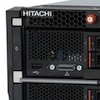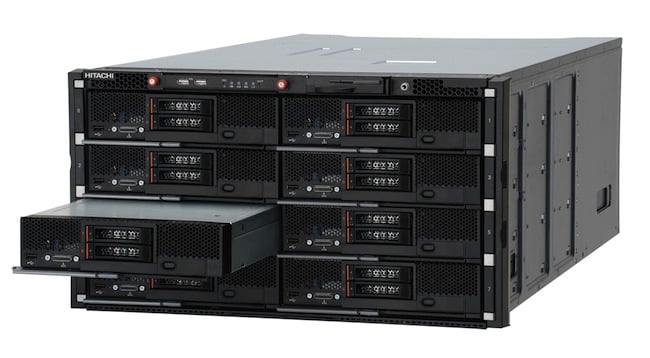
The Blade 500 is Hitachi’s new 6U rack mount blade server system, supporting up to 8 server blades plus I/O and management hardware. Hitachi’s flexible architecture and logical partitioning features are ideal for organizations with diverse data storage needs, allowing the multiple applications to securely co-exist on the same hardware. The Blade 500 is also the first Hitachi Data Systems product to incorporate the Intel Xeon E5-2600 processor.
The Blade 500 is Hitachi’s new 6U rack mount blade server system, supporting up to 8 server blades plus I/O and management hardware. Hitachi’s flexible architecture and logical partitioning features are ideal for organizations with diverse data storage needs, allowing the multiple applications to securely co-exist on the same hardware. The Blade 500 is also the first Hitachi Data Systems product to incorporate the Intel Xeon E5-2600 processor.

The Hitachi Compute Blade 500 joins the Blade 2000 and the Blade 320 and a family of rack-optimized servers, Hitachi Compute Rack, that are the foundation for dedicated, packaged solutions like the Hitachi Content Platform (HCP).
Key Features
- 6U chassis houses up to 8 server blade modules
- 1 or 2 Intel Xeon E5 CPUs per blade
- Integrated chassis management
- Mainframe-class availability features (hot-swap, redundant components, automated failover)
- Large maximum memory configurations with a combined total addressable memory of over 12TB
- Hardware based logical partition (LPAR) capability for secure, high performance virtualization
- Choice of switched fabric options, including IP, FC and converged fabric
- Securely host multiple workloads in a single blade chassis with dynamic partitions in shared mode
- Mix direct PCIe (Gen 3.0) and shared I/O
The Blade 500 features native logical partition (LPAR) technology implemented in firmware to improve virtual server isolation, typically a feature only associated with Hitachi’s high-end enterprise platforms. The Blade 500 system supports the co-existence of its native logical partitioning capabilities and different software hypervisors in the same chassis.
Server management and system monitoring are available with the Hitachi Compute Systems Manager (HCSM) which can integrate with Hitachi Command Suite (HCS) in IT environments using Hitachi storage.
Throughput and Connectivity
The Hitachi Content Platform is intended to reduce dependency on proprietary server environments and switched-only I/O fabrics by offering blade flexibility and converged I/O fabric support. The Blade 500 supports a mix of both integrated switched fabric and direct access to I/O slots provided by onboard PCIe 3.0 slots. These specifications should support deploying the Blade 500 as a platform for virtualized infrastructures and cloud applications.
This model also introduces an embedded 10 Gigabit Ethernet switch to increase scalability and enhance virtual machine mobility, further simplifying management by reducing the operational overhead of virtualized blade server environments. The switch has a non-blocking, cut-through architecture for ultra-low latency, and dual speed (1Gbps/10Gbps) capable external ports.
High Availability Open Architecture
The open architecture of Hitachi Compute Blade 500 allows the system to be configured for a mix of virtualized applications and converged platform solutions. Server resources can be dynamically reallocated to match workload changes, and high availability is achieved through redundancy, hot-swap and automated cold standby failover.
Availability
Reference Blade 500 architectures for Microsoft Hyper-V Cloud Fast Track and VMware vCloud Director are available from Hitachi. Converged data center solutions that feature Hitachi Compute Blade 500 will be available from Hitachi in coming months.
